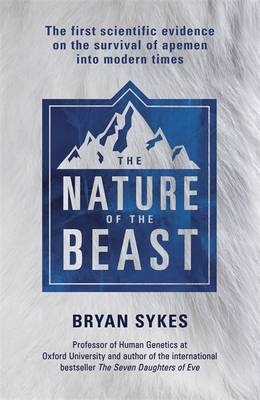
The Nature of the Beast
The first genetic evidence on the survival of apemen, yeti, bigfoot and other mysterious creatures into modern times
Seiten
2015
Coronet Books (Verlag)
978-1-4447-9125-9 (ISBN)
Coronet Books (Verlag)
978-1-4447-9125-9 (ISBN)
- Titel ist leider vergriffen;
keine Neuauflage - Artikel merken
How science uncovered the true identity of the Yeti, Bigfoot, Almasty and other mysterious creatures.
Professor Bryan Sykes, the world's leading expert on human genetics, set a goal to locate and analyse as many DNA samples as possible with links to the yeti. In doing so, he found himself entering a strange world of mystery and sensationalism, fraud and obsession and even the supernatural.
Protected by the ruthless vigour of genetic analysis he was able to listen to the stories of the yeti without having to form an opinion. The only opinion that mattered was the DNA.
Three hair samples from the miogi, the Bhutanese yeti are the cause of the investigation. The hairs did not surrender their secrets easily, but eventually two were identified as known species of bear. The third remained a mystery.
One of the many theories to account for the yeti legend is that there were small groups of Neanderthals that had managed to survive until recent times. If so, would it be possible to detect recent interbreeding between our own species and Neanderthals in the genomes of indigenous people living in remote regions?
Professor Sykes has made some surprising and significant discoveries. Discoveries that could change our understanding of human origins.
Professor Bryan Sykes, the world's leading expert on human genetics, set a goal to locate and analyse as many DNA samples as possible with links to the yeti. In doing so, he found himself entering a strange world of mystery and sensationalism, fraud and obsession and even the supernatural.
Protected by the ruthless vigour of genetic analysis he was able to listen to the stories of the yeti without having to form an opinion. The only opinion that mattered was the DNA.
Three hair samples from the miogi, the Bhutanese yeti are the cause of the investigation. The hairs did not surrender their secrets easily, but eventually two were identified as known species of bear. The third remained a mystery.
One of the many theories to account for the yeti legend is that there were small groups of Neanderthals that had managed to survive until recent times. If so, would it be possible to detect recent interbreeding between our own species and Neanderthals in the genomes of indigenous people living in remote regions?
Professor Sykes has made some surprising and significant discoveries. Discoveries that could change our understanding of human origins.
Bryan Sykes is a Professor of Human Genetics at the University of Oxford and a Fellow of Wolfson College. He has been involved in a number of high-profile cases dealing with ancient DNA, including those of 'Otzi the Iceman', a well preserved natural mummy of a man who lived around 3,300 BC and 'Cheddar Man', the remains of a man found in Cheddar Gorge, from approximately 7150 BC, it is Britain's oldest complete human skeleton. Professor Sykes in best known outside the community of geneticists for his bestselling books on the investigation of human history and pre-history through studies of mitochondrial DNA.
| Erscheint lt. Verlag | 9.4.2015 |
|---|---|
| Sprache | englisch |
| Maße | 170 x 240 mm |
| Gewicht | 582 g |
| Themenwelt | Sachbuch/Ratgeber ► Natur / Technik ► Natur / Ökologie |
| Informatik ► Weitere Themen ► Bioinformatik | |
| Naturwissenschaften ► Biologie ► Genetik / Molekularbiologie | |
| ISBN-10 | 1-4447-9125-7 / 1444791257 |
| ISBN-13 | 978-1-4447-9125-9 / 9781444791259 |
| Zustand | Neuware |
| Haben Sie eine Frage zum Produkt? |
Mehr entdecken
aus dem Bereich
aus dem Bereich
Buch | Softcover (2021)
Springer Spektrum (Verlag)
49,99 €
Grundlagen, Algorithmen, Anwendungen
Buch | Hardcover (2022)
Wiley-VCH (Verlag)
79,90 €


